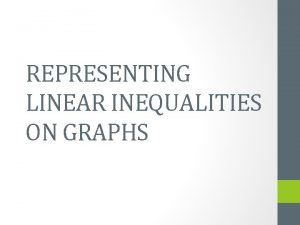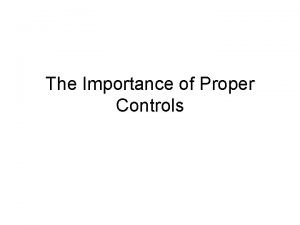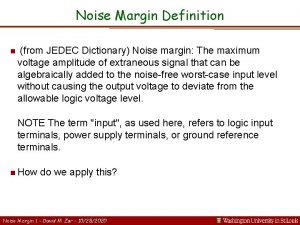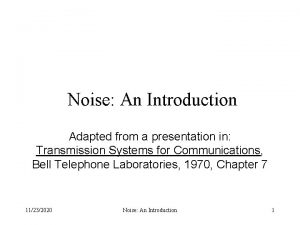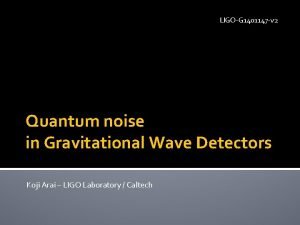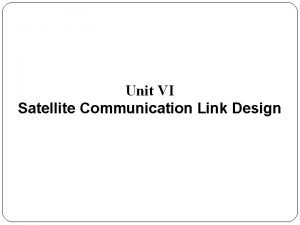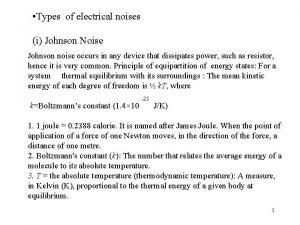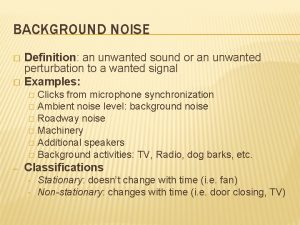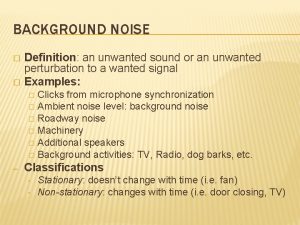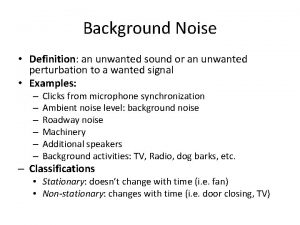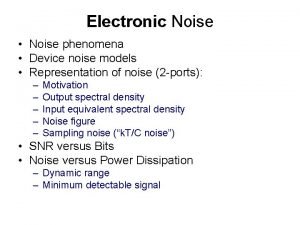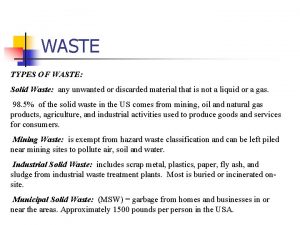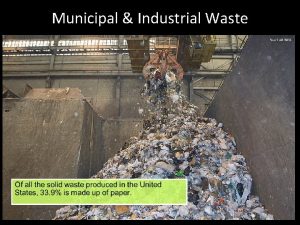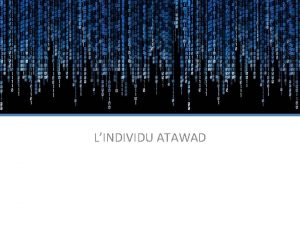Noise What is NOISE A definition Any unwanted




















- Slides: 20

Noise • What is NOISE? A definition: Any unwanted signal obscuring signal to be observed two main origins • EXTRINSIC NOISE examples. . . pickup from external sources unwanted feedback RF interference from system or elsewhere, power supply fluctuations ground currents small voltage differences => currents can couple into system may be hard to distinguish from genuine signals but AVOIDABLE Assembly & connections, especially to ground, are important • INTRINSIC NOISE Fundamental property of detector or amplifying electronics Can’t be eliminated but can be MINIMISED g. hall@ic. ac. uk www. hep. ph. ic. ac. uk/~hallg/ 1 14/09/2021

Origins of noise in amplifying systems • 1. Thermal noise Quantum-statistical phenomenon Charge carriers in constant thermal motion macroscopic fluctuations in electrical state of system • 2. Shot noise Random fluctuations in DC current flow originates in quantisation of charge non-continuous current • 3. 1/f noise Characteristic of many physical systems least well understood noise source commonly associated with interface states in MOS electronics g. hall@ic. ac. uk www. hep. ph. ic. ac. uk/~hallg/ 2 14/09/2021

Thermal noise • Einstein (1906) , Johnson, Nyquist (1928) Mean voltage <v> = 0 Variance <v 2> = 4 k. T. R. ∆f s(v) = √<v 2> = 1. 3 10 -10 (R. ∆f)1/2 e. g. R = 1 MΩ ∆f = 1 Hz gaussian distribution ∆f = observing bandwidth of fluctuations in v volts at 300 K s(v) = 0. 13µV Noise power = 4 k. T. ∆f independent of R & q independent of f - WHITE • Circuit representations Noise generator + noiseless resistance R • Spectral densities mean square noise voltage or current per unit frequency interval w. V(f) = 4 k. TR (voltage) g. hall@ic. ac. uk www. hep. ph. ic. ac. uk/~hallg/ w. I(f) = 4 k. T/R (current) 3 14/09/2021

Shot noise • Poisson fluctuations of charge carrier number eg arrival of charges at electrode in system - induce charges on electrode quantised in amplitude and time • Examples electrons/holes crossing potential barrier in diode or transistor electron flow in vacuum tube < in 2> = 2 q. I. ∆f WHITE I = DC current (NB notation e = q) gaussian distribution of fluctuations in i g. hall@ic. ac. uk www. hep. ph. ic. ac. uk/~hallg/ 4 14/09/2021

1/f noise • White noise sources frequently dominate in many real systems however frequency dependent noise is also common • 1/f noise is a generic term for a wide range of phenomena, possibly not always related Power spectral density w(f) = Af/fn n ~ 0. 8 -1. 5 typical • Most important for MOS FET devices, often dominates but can also arise in other circumstances e. g. dielectrics, … p. MOS transistor noise spectrum g. hall@ic. ac. uk www. hep. ph. ic. ac. uk/~hallg/ 5 14/09/2021

Campbell’s theorem • Most amplifying systems designed to be linear S(t) = S 1(t) + S 2(t) +S 3(t) + … • Impulse response h(t) = response to d • Transfer function H(w) = vout(w)/vin(w) = ∫-∞∞ h(t). e-jw t dt ie impulse response h(t) and transfer function H(w) are Fourier pair • In a linear system, if random impulses occur at rate n average response <v> = n ∫-∞tobs h(t)dt variance s 2 = n ∫-∞tobs [h 2(t)]dt so s 2 = n ∫-∞∞ h 2(t) dt g. hall@ic. ac. uk i. e. sum all pulses preceding time, tobs, of observation = n ∫-∞∞|H(w)|2 df www. hep. ph. ic. ac. uk/~hallg/ 6 14/09/2021

Amplifier systems for spectroscopy • typical application - precise measurements of x-ray or gamma-ray energies • pre-amplifier first stage of amplification • main amplifier - adds gain and provides bandwidth limiting ADC - analogue to digital conversion - signal amplitude to binary number • fast amplifier and logic start ADC ("gate") and flag interesting "events" to DAQ system - most signals arrive randomly in time. Other logic required to maximise chance of "good" event, eg second detector g. hall@ic. ac. uk www. hep. ph. ic. ac. uk/~hallg/ 7 14/09/2021

"Rules" of low noise amplifier systems • Combine uncorrelated noise sources in quadrature e 2 tot = e 12 + e 22 + e 32 + … + in 2 R 2 +. . . follows from Campbell's theorem consider as combinations of gaussian distributions • First stage of amplifier dominates noise originates at input transistor is most important - defines noise in most cases • Noise is independent of amplifier gain or input impedance so noise can be referred to input • In real systems both are approximations - but normally good ones so often sufficient to focus on input device g. hall@ic. ac. uk www. hep. ph. ic. ac. uk/~hallg/ 8 14/09/2021

Amplifiers - dominance of input stage • Amplifier systems (and amplifiers!) usually consist of several stages impractical to put all gain at one location - power, heating, material, size, . . . • Calculate signal and noise at output Sout = G 1. G 2. G 3 Sin for 3 stage system, but can easily extend to N (eout)2= G 12. G 22. G 32 e 12 + G 22. G 32 e 22 + G 32 e 32 (eout /Sout) 2 = (e 12 + e 22/G 12 + e 32 /G 12. G 22)/Sin 2 • Desirable to maximise gain at input stage eg stage 1 boosts signal enough for transmission down cable and should be large enough that environmental noise is not significant g. hall@ic. ac. uk www. hep. ph. ic. ac. uk/~hallg/ 9 14/09/2021

Amplifiers - location of noise sources • Normal to partition noise sources not fundamental to calculations but can simplify! • Parallel noise sources appear as currents at input detector leakage current bias resistors feedback resistor Series noise sources appear as voltage at input … transistor gate noise device series resistance microstrip or transistor load resistor in amplifier. . . g. hall@ic. ac. uk www. hep. ph. ic. ac. uk/~hallg/ 10 14/09/2021

Amplifiers - reference to input assume: signal source and associated impedance noise sources amplifier with gain & input impedance • noise at output Eno 2 = A 2 {e 2 n. Z 2 in/(Zin + Rs)2 + i 2 n. R 2 s. Z 2 in/(Zin + Rs)2 } • transfer function K = Vout/Vin = A. Vsig. Zin /(Zin + Rs)Vsig = AZin/(Zin + Rs) • noise at input Eni 2= Eno 2/K 2 => E 2 ni = e 2 n + i 2 n. R 2 s no Zin or A dependence easy to show analogous result I 2 ni = i 2 n + e 2 n/R 2 s choice is for convenience in most detector systems, there is a current signal source and a parallel capacitance • then the spectral distribution of noise at the input is affected I 2 ni = i 2 n + e 2 nw 2 C 2 g. hall@ic. ac. uk www. hep. ph. ic. ac. uk/~hallg/ no longer white 11 14/09/2021

Preamplifier types • Current sensitive - common for photodiode signals vout ≈ -iin. Rf • signals follow input current, ie fast response but not lowest noise • Charge sensitive amplifier Ideally, simple integrator with Cf but need means to discharge capacitor - large Rf • Simple integrator vout ≈ -Q/Cf • with feedback resistor Rf vout(t) ≈ -(Q/Cf)exp(-t/t) g. hall@ic. ac. uk t = Rf Cf www. hep. ph. ic. ac. uk/~hallg/ 12 14/09/2021

Signal processing • Knowing Noise sources Amplifier components and basic design How to achieve “best” signal to noise? • Possible constraints power consumption layout of system (space, cables, …) signal rate eg. signal "pileup" vs E resolution • Two methods Pulse shaping time invariant filter Pulse sampling time variant filter g. hall@ic. ac. uk www. hep. ph. ic. ac. uk/~hallg/ 13 14/09/2021

Noise after pulse shaping • General result is ENC 2 = aen 2 C 2/t + b in 2 t + g. C 2 a, b depend on pulse shape calculate in t or f g : 1/f - can be computed in f only a minimum noise can be achieved with a given shaping time constant chosen depending on magnitudes of noise sources • Useful point of comparison: CR-RC bandpass filter only 36% worse than theoretical optimal filter g. hall@ic. ac. uk www. hep. ph. ic. ac. uk/~hallg/ 14 14/09/2021

Equivalent Noise Charge • ENC = signal which produces output amplitude equal to r. m. s. noise desirable to measure in absolute units - e, coul, ke. V(Si), . . • Noise must be compared with known signal to calibrate system • How to inject an impulse of known size? Qtest = Ctest. Vtest = Ne measure Vout for known Qtest g. hall@ic. ac. uk www. hep. ph. ic. ac. uk/~hallg/ 15 14/09/2021

Some numerical values • An approximate numerical value • using CR-RC filter, ignoring 1/f noise ie I = 1 n. A t = 1µs ENCp ≈ 100 e Rs = 10Ω g. hall@ic. ac. uk C = 10 p. F t = 1µs www. hep. ph. ic. ac. uk/~hallg/ ENCs ≈ 24 e 16 14/09/2021

Time variant filters • Alternative to pulse shaping filters based on summation • Sample & hold method Vout initially switches S 0 B 1 B 2 open, S 1 S 2 closed switch S 0 is Reset Vout = output from charge sensitive preamplifier open S 1 : preserves Vout on C 1 after time ∆t open S 2 : preserves Vout on C 2 then, close B 1 and B 2: output A = V 1 - V 2 reset preamp later • need to know when signal will arrive! Switched capacitor easy to implement convenient for MOS technology g. hall@ic. ac. uk www. hep. ph. ic. ac. uk/~hallg/ 17 14/09/2021

Integrating Analogue to Digital Converter (ADC) • Integrate signal during application of gate - another time variant filter convert charge to digital number • = convolution of pulse shape with gate so w(t) = h(t) * ggate(t) (ignoring t reflection) • Tgate << t Tgate >> t w(t) = h(t) Tgate = 5 t new, wider weighting function can change filtering and increase or decrease noise g. hall@ic. ac. uk www. hep. ph. ic. ac. uk/~hallg/ 18 14/09/2021

Digitisation noise • Eventually need to convert signal to a number quantisation (rounding) of number = noise source the more precise the digitisation, the smaller the noise • After digitisation all that is known is that signal was between -∆/2 and ∆/2 <x> = ∫x. p(x). dx/∫p(x). dx s 2 = <x 2> = ∫x 2. p(x). dx /∫p(x). dx = ∫-∆/2∆/2 dx = [x] ∫x 2. p(x). dx = ∫-∆/2∆/2 x 2. dx = [x 3/3] so -∆/2 =∆ -∆/2 = 2∆3/24 s 2 = ∆2/12 • ie statistical noise which is proportional to digitisation unit g. hall@ic. ac. uk www. hep. ph. ic. ac. uk/~hallg/ 19 14/09/2021

Time measurements and noise • When did signal cross threshold ? noise causes “jitter” Dt = snoise/(d. V/dt) • compromise between bandwidth (increased d. V/dt) noise (decreased bandwidth) • limits systems where preamplifier pulse used to generate trigger eg x-ray detection • typical preamp response V = Vmax(1 -e-t/trise) so ∆t ≈ snoisetrise/ Vmax g. hall@ic. ac. uk t << t www. hep. ph. ic. ac. uk/~hallg/ 20 14/09/2021
 Quantization noise in pcm
Quantization noise in pcm Example of an open letter format
Example of an open letter format It is an unwanted, aggressive behavior
It is an unwanted, aggressive behavior Shade the unwanted region
Shade the unwanted region Corrective controls reveal or discover unwanted events.
Corrective controls reveal or discover unwanted events. Is an unwanted aggressive behavior
Is an unwanted aggressive behavior Characteristics of human being
Characteristics of human being Unwanted roomatr
Unwanted roomatr It is an unwanted, aggressive behavior. *
It is an unwanted, aggressive behavior. * Unwanted
Unwanted Some or any bananas
Some or any bananas Any to any connectivity
Any to any connectivity Any question atau any questions
Any question atau any questions Noise margin meaning
Noise margin meaning Semantic noise meaning
Semantic noise meaning Noise pollution definition
Noise pollution definition Noise definition
Noise definition Ligog
Ligog Carrier to noise ratio
Carrier to noise ratio Types of electrical noise
Types of electrical noise What is linear model of communication
What is linear model of communication



